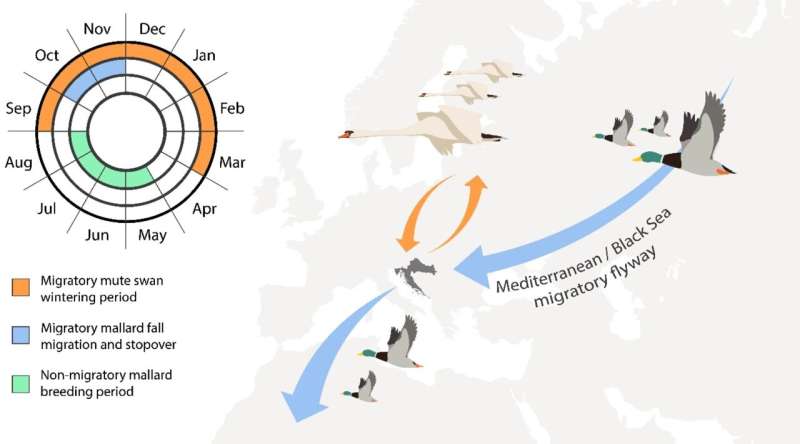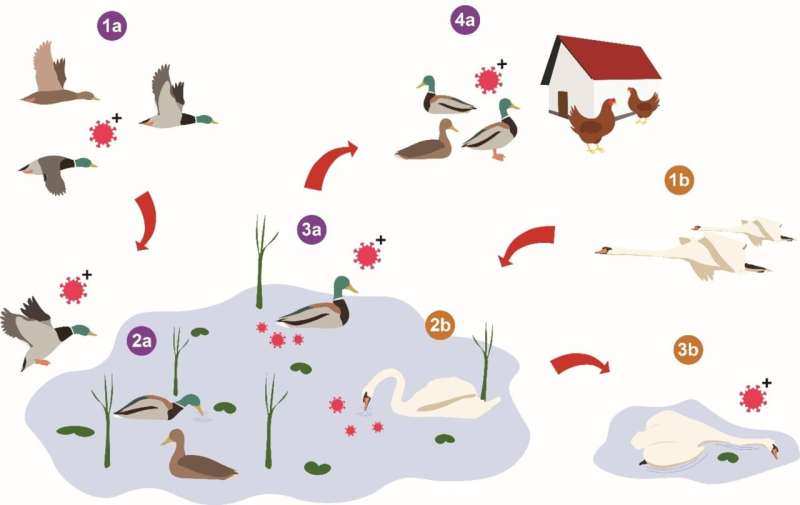This article has been reviewed according to Science X's editorial process and policies. Editors have highlighted the following attributes while ensuring the content's credibility:
fact-checked
peer-reviewed publication
trusted source
proofread
Backyard poultry at risk of bird flu when migrating mallards stop to rest

Knowing where, when and for how long mallard ducks—natural carriers of avian influenza—stop and rest as they migrate can help predict the probability that they will spread bird flu to backyard poultry flocks.
The finding, from a study published in the journal Scientific Reports, takes an important step in explaining the transmission dynamics of bird flu, a strain also known as Highly Pathogenic Avian Influenza (HPAI), and could one day inform people with backyard poultry of the best times to take extra precautions to isolate their birds from wild ones.
The researchers used a computer model to predict infection risk to backyard poultry, resident mallards and overwintering mute swans in Croatia, which serves as a stopover area for both migratory mallards and the swans. While mallards tolerate avian influenza well, it is fatal to mute swans; the dead birds can serve to alert people to the presence of bird flu that is otherwise hard to detect in the wild.
Though Croatia served as a study system in this paper, the results are relevant to other places, including the U.S., where mute swans and mallards both exist.
"The virus has jumped independently at different times from wild birds to dairy cows," said Sebastian Llanos-Soto, a doctoral student in the lab of senior author Renata Ivanek, professor of epidemiology in the Department of Population Medicine and Diagnostic Sciences in the College of Veterinary Medicine.
"There is an urgent need to improve our ability to predict the introduction of avian influenza at the wildlife-domestic animal interface and our study contributes to this goal," Llanos-Soto said.
The current strain of HPAI was first detected in North America in November 2021. It has since spread—often via wild birds (especially waterfowl)—to poultry, dairy cattle, domestic cats, many species of wildlife and 68 people to date, though there is no evidence of person-to-person transmission.

Infected raw cow milk has been a source of infection mainly to cats and is considered risky for human consumption. HPAI can infect domesticated chickens, turkeys, ducks and geese. Public health professionals are concerned that if a person infected with a common flu also contracts HPAI, DNA from the two viruses has a potential to mix, creating a new strain capable of transmitting between people.
"Eventually, because we are in contact with our domestic animals, there could also be a risk to humans," Llanos-Soto said.
In the study, the computer model was informed with migratory data, with migratory mute swans arriving in Croatia between September and November to winter and returning to breeding grounds between February and April. Mallards arrive between October and November for a stopover of seven to 28 days in Croatia before continuing on their migration through the Mediterranean-Black Sea flyway.
The model simulated the transmission of HPAI in an area considered to be of high risk for introduction into poultry farms via waterfowl. The model was validated with real-world bird and farm data from the study area.
The computer model suggested that prior immunity—when birds are previously infected and survive, rendering them immune to future exposures to the same virus—could play a role in predictions of infection risk, but determining whether wild birds are immune would be very challenging, Llanos-Soto said.
In order for these findings to be applied in real-world settings, more information is needed to understand wildlife dynamics and factors that affect the transmission of the virus in these wild/domesticated bird communities, Llanos-Soto said.
"What makes migrating mallard stopovers shorter or longer?" he said. "We need to know those kinds of things to better understand the risk of infection to our domestic animals."
More information: Sebastián G. Llanos-Soto et al, Transmission dynamics of highly pathogenic avian influenza among multiple waterfowl species and backyard poultry: the impact of the stopover period, Scientific Reports (2025). DOI: 10.1038/s41598-025-89827-y
Journal information: Scientific Reports
Provided by Cornell University



















